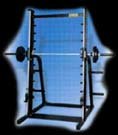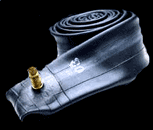Seriously, ask any boxer about the importance of a strong neck. Powerful blows to the head, think "Mike Tyson", would probably KILL a pencil-neck at the spot. But even the most pacifistic guy in town can trip or have something fall onto him, causing the same kind of impact. And speaking for myself, I'm not a huge guy but thanks to my neck-training regime I avoided a nasty injury to my neck in a snowboard-accident a few years ago. If I hadn't been able to brace myself I very well might have suffered some kind of spinal injury. As it is now, I got away with a couple of days of headache. Who plans on doing these things?
 You don't - you're just damn happy that one time in your life when you save your neck. And it doesn't even have to be something as violent as an accident or a fight - hours in front of a computer with bad posture can put strain on the neck. Weak muscles can't protect the spine as well, and you might suffer a wide array of ailments. Not to say that a bull-neck would solve every problem that the average secretary has, but rather that some of them would at least be better off if they got their musculature up to par.
You don't - you're just damn happy that one time in your life when you save your neck. And it doesn't even have to be something as violent as an accident or a fight - hours in front of a computer with bad posture can put strain on the neck. Weak muscles can't protect the spine as well, and you might suffer a wide array of ailments. Not to say that a bull-neck would solve every problem that the average secretary has, but rather that some of them would at least be better off if they got their musculature up to par.
In conclusion, developing your neck makes you look stronger, healthier, and might protect you from trouble down the road. With this said, there's just a minor warning I'd like to issue before we go all Gung-Ho about the training:
WARNING:
The neck is by nature a weak structure. We'll change that, of course, but when you start out, odds are you're much weaker than you think. Excess weights and intensity can be counterproductive, if not downright dangerous. Form is also vital. Don't solely rely on the descriptions found here, consult with a professional to get your form right. People with a history of neck-injuries should consult with their physician about whether they should take on neck-training at all.
Look guys, this is not a speech I make just to avoid legal trouble, but because the neck is vulnerable and might cause you great trouble if you overdo it in the beginning! Go easy!
SHRUGS
Now this is a CLASSIC. Everybody with an ego bigger than biceps loves this, because they can cheat like crazy with impressive weights. Granted, they don't really move the weights with their traps, but it looks cool. For those of you who want results instead of injuries, the approach is slightly different: Safety first. Whenever you handle the weights, make sure to keep a flat back and your abs tense. Try to maintain balance and absolute control, even if you're just racking the weights.
 Shrugs can be done with a barbell, dumbbells, a seated shrug-machine, or a standing calf press. In my opinion, the barbell and the shrug-machine is out of the question right away. The barbell will force you to stand unbalanced, as the bar will be a couple of inches away from your center of gravity. The machine don't have this problem, but unless you have two spotters to hand you the handles, you must round your back to reach down and grab them yourself. In addition, all seated training with heavy weights should be avoided if possible, since your spine is ill suited for sitting pressure. Your risk of injury is considerably higher whenever you SIT down to do any kind of presses over your head - or lifting, as the case is here.
Shrugs can be done with a barbell, dumbbells, a seated shrug-machine, or a standing calf press. In my opinion, the barbell and the shrug-machine is out of the question right away. The barbell will force you to stand unbalanced, as the bar will be a couple of inches away from your center of gravity. The machine don't have this problem, but unless you have two spotters to hand you the handles, you must round your back to reach down and grab them yourself. In addition, all seated training with heavy weights should be avoided if possible, since your spine is ill suited for sitting pressure. Your risk of injury is considerably higher whenever you SIT down to do any kind of presses over your head - or lifting, as the case is here.
What is left is dumbbells and standing calf-press machine. Dumbbell-shrugs should be executed as follows:
Get a good grip of the dumbbells (straps might be a good idea if your grip gives up before your traps). Stand balanced with feet shoulder-width apart, knees slightly bent, abs tense, and shoulders back. Keep your arms slightly tense to avoid "hanging on the joints", but not flexed so you get lactic acid buildup. As you start, shrug upwards/backwards as if you were trying to have the top part of your shoulders touching your ears. To get an extra squeeze, make sure to pull the shoulders back half an inch extra at the top. Slowly return down to the starting position, and immediately begin the next rep. Don't bounce.
The calf-press machine is very simple: Stand exactly as described above, but without grabbing the dumbbells. Instead, stand relaxed with your feet securely planted on the foot-pad (if the pad is small, make sure to get your heels right. You have to use your judgment on different machines - if the design don't allow you to perform the movement safely, go with another machine or use dumbbells). As you lift the shoulder-pads, make sure to lift with your LEGS, not your back! Grab the front of the machine for balance. With the shoulder-pads securely and evenly on your shoulders, shrug up like you were saying "I don't know". Squeeze for a second at the top, then slowly return down and immediately start your next rep.
The nice thing about calf-press machines, is that a person with weak or sensitive hands, or with some kind of injury, gets the arms totally out of the equation. The Dumbbell-option on the other hand, allows for more freedom of movement. The effectiveness should be pretty similar though. Regardless of what option you chose, keep the range of motion simple. Rolling backwards and forwards in complex series won't do anything.
Ok, so now you got the classic shrug straight. Great! However, contrary to popular belief, shrugs are not the one and only way to a bull-neck. It's an excellent exercise - I say use it 4 times out of 5 when you train neck - but it's a mistake to think that you can maximize your potential using only shrugs. It's like relying solely on bicep curls to get thick arms. Sure, you've got a great start, but you're not really there until you throw in the component exercises.
So, for the other components there's a slight problem: I don't think there's any generally assigned names, not the way a Deadlift or a Bench press is crystal clear. If you think you've got a better name for the exercises described below, I suggest that you write it down neatly on a list, categorize it alphabetically, and hand it to someone who cares about neat lists rather than getting a brutal physique.
REAR NECK CURLS
 Some better gyms actually have a special machine for the neck. This is great, but if your gym doesn't have one - no problem, you can do it using a smith-machine instead (which practically all gyms have). The neck machine usually looks like a chair from the Spanish Inquisition. And the execution is simple: Sit down with the back of your head against the pad (make sure to get the right height) and keep your body straight and stationary while bobbing your head back and forth like one of those plastic birds you see in gift-stores.
Some better gyms actually have a special machine for the neck. This is great, but if your gym doesn't have one - no problem, you can do it using a smith-machine instead (which practically all gyms have). The neck machine usually looks like a chair from the Spanish Inquisition. And the execution is simple: Sit down with the back of your head against the pad (make sure to get the right height) and keep your body straight and stationary while bobbing your head back and forth like one of those plastic birds you see in gift-stores.
When using a Smith-machine, it's slightly more complicated: Roll up a towel so that is fits steadily between the back of your head and the bar. Kneel on a bench while supporting your upper body with both arms. Have your training partner unlock the bar (don't even THINK of doing this exercise without a partner!!) and gently fit the bar against the towel. Now, keeping your body still, bob your head like a bird who's tipped forward 90 degrees.
This is a prime example of using too much weight and having the potential to giving you plenty of trouble. Go light, preferably in the 12-15 reps range, minimum. Put your efforts into getting the movement safe. The effectiveness comes with safety.
NECK CURLS - view exercise
Lie down on your back on a bench with your head and neck out from the edge of the bench. Fold a small towel to cover your forehead. Grab a small weight plate and hold it against your forehead. Keeping your body firmly against the bench (abs tense, knees bent), bob your head. To get the right feel of the exercise, try looking at the floor in the far end of the gym at the bottom, and your own toes at the top. As with all neck exercises, focus is paramount. Consciously stretch the muscles at the bottom, and squeeze them all the way to the top. Be attentive to any feelings of pulling or crunching, or light, stinging joint pain.
CARNIVORE-TWISTS
 Let me be honest with you: I have never done this one myself. But it's a perfectly valid way of training your neck, so I'd be stupid not to mention it. The reason I haven't done it is mainly that it's not a "gym-exercise", but rather a home exercise … And I've always been able to achieve the desired effect in the gym. For someone with a less well-equipped gym, it might be worth a look.
Let me be honest with you: I have never done this one myself. But it's a perfectly valid way of training your neck, so I'd be stupid not to mention it. The reason I haven't done it is mainly that it's not a "gym-exercise", but rather a home exercise … And I've always been able to achieve the desired effect in the gym. For someone with a less well-equipped gym, it might be worth a look.
The basic idea is to get a good and elastic rubber-like string, like the inner tire of a bicycle tire or a slim bungee-cord. You get the idea. Whatever you chose though, I strongly suggest that you get a NEW item. You'll see why. The stance is on all four on the floor, with your bungee-cord/tire/whatever in one or two paws. Err… Hands. Bite down hard at a point where you'll get a good range of motion, and pull with your teeth as if you were a dog ripping off meat from a bone. You get the idea - an upward/backward/twisting motion, holding the other end of he item steadily against the floor. Do I need to emphasize "steady"? Ever seen a Tom and Jerry cartoon where Tom tried to sling something at Jerry, but got a good slap in the face instead? Well, I think you get the idea.
NECK BREAKERS
This is actually a collective name for a variety of exercises, but the one thing they have in common is that they deserve the name if you don't watch your weights and form. If you know what you're doing, it's perfectly fine for the advanced neck-trainer though.
What I'm referring to is one of those leather-kind of head-caps with chains for you to attach plates to. These are rarely found outside good ol' dungeon-like powerlifter-style gyms, but trust me - if you know how to use it, you'll enjoy way more freedom and room for creativity than any machine can provide. With one those, you can train the rear, front, and sides of your neck, just as easily as all kinds of twisting movements. You can do it standing, seated, or lying - the choice is yours! The freedom is total, but as always when there's no set groove, there's an obvious risk of deviation from the intended range of motion. A training partner is good, a Personal Trainer is better. Oh, and a dash of common sense (such as leaving the ego in the locker room) doesn't hurt either.
Thanks,
